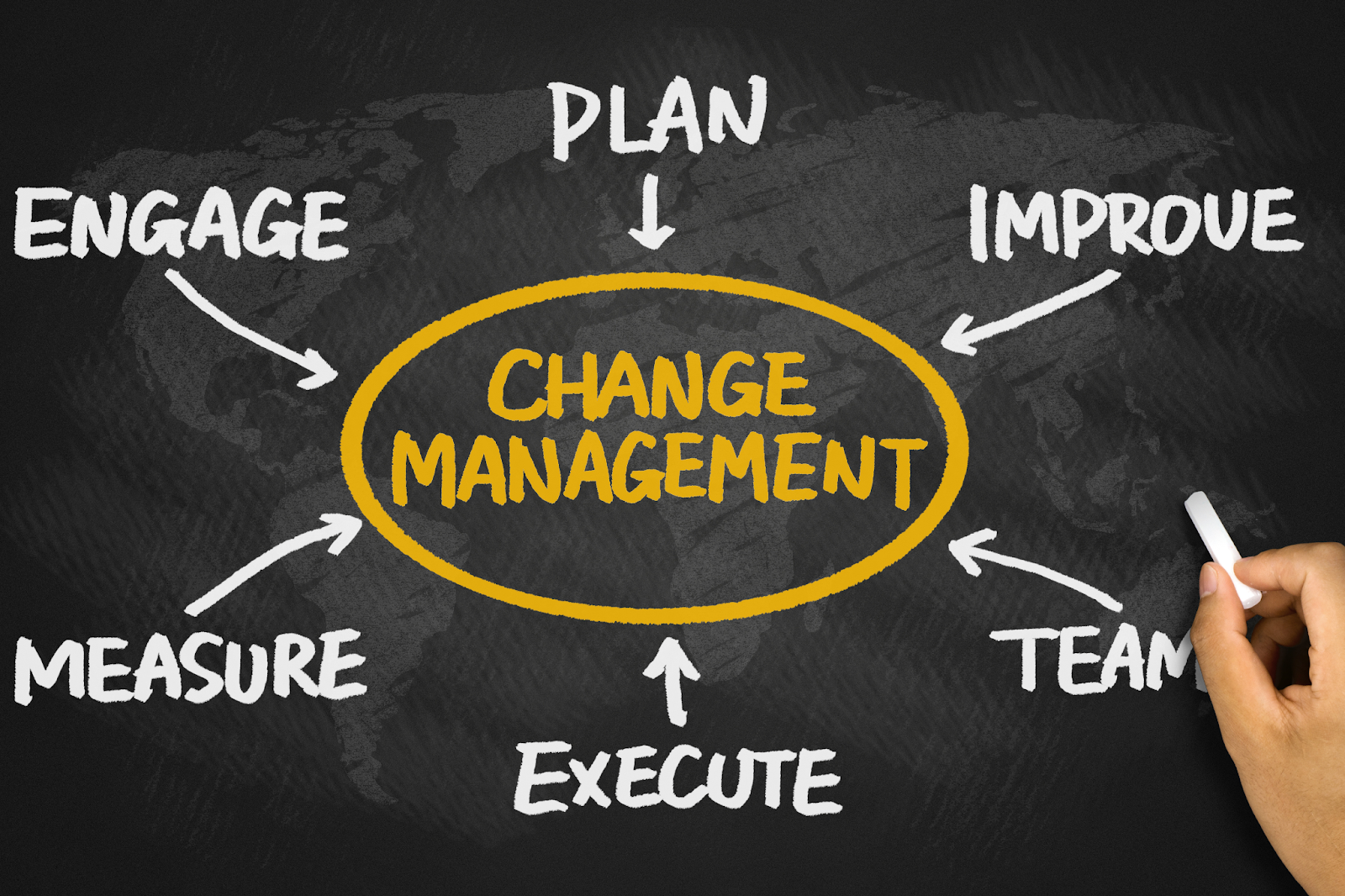Today, it's all about leading change with agility, using data-driven insights, and focusing on the human aspect of transformation.
In this post, we’ll take you on a journey through the future trends in leadership, the most recent changes in management and industry, and the change management trends you need to be aware of.
These trends aren’t just shaping change management training today—they’re defining what successful leadership looks like in 2025 and beyond.
What is Change Management?
Change management refers to the structured approach organizations take to manage and guide their people through organizational change. It involves preparing, supporting, and helping individuals, teams, and organizations make successful transitions from the current state to a desired future state.
The goal of change management is to minimize resistance, maximize engagement, and ensure that the change initiative is sustainable and effective.
Why is Change Management Training Important
Change management training is increasingly important for the future of work because organizations are faced with continuous transformations—be it due to technological disruptions, market shifts, or evolving workforce expectations.
A study from McKinsey & Company found that 70% of large-scale change initiatives fail, often due to poor change management practices. Proper change management training ensures that leaders are equipped to guide their teams through change smoothly, reduce resistance, and drive long-term success.
1. The Changing Role of Leadership in Change Management

Gone are the days when leaders simply managed operations from the top down. Today, leaders must inspire and lead change across every level of the organization. The way leaders approach change, how they communicate, implement, and manage transformation, has evolved.
- Leadership is no longer about control: It’s about guiding, coaching, and empowering teams to adapt.
- Change leadership training equips leaders with the tools to inspire, engage, and support their teams during transitions.
- The shift from management to leadership means that leaders must foster trust, transparency, and collaboration to drive change successfully.
Actionable Tip: Invest in change leadership training that focuses on emotional intelligence, communication skills, and empathy to make leaders more effective during organizational change.
2. Digital Transformation is Shaping Change Management
The digital revolution has forced companies to adopt new technologies at an accelerating pace. From automation to artificial intelligence (AI), technology is reshaping industries and transforming how work gets done.
Recent Changes in Management and Industry
- Digital transformation is disrupting industries, requiring leaders to manage technological adoption effectively.
- This has led to the rise of AI-driven change management tools that help predict and manage resistance, and provide real-time analytics for tracking change initiatives.
Key Trends
- AI & Data Analytics: Predictive tools help leaders understand employee sentiment and manage change more effectively.
- Automation: Technology allows companies to implement change with more precision, ensuring fewer disruptions and smoother transitions.
Teamland offers change management training that integrates digital tools to ensure leaders understand not just how to implement new tech, but how to manage the cultural shift that comes with it. Their change leadership training focuses on equipping leaders with the skills to manage technological transitions in a way that minimizes resistance and maximizes engagement.
3. Agile Change Management

As the business environment becomes increasingly unpredictable, traditional, rigid change management methods are becoming outdated. In today’s world, agile change management is gaining traction as it offers organizations flexibility and the ability to adapt quickly to shifting circumstances.
What Agile Brings to Change Management
- Iterative Changes: Instead of waiting for months to roll out a full-scale change, agile allows teams to introduce incremental changes over time.
- Faster Feedback Loops: Teams can react to feedback quickly, improving change initiatives continuously.
- Collaborative Approach: Agile emphasizes collaboration between teams, leaders, and employees at all levels.
How to Implement Agile Change Management
- Break large change initiatives into smaller, manageable chunks.
- Focus on continuous improvement and adjust strategies based on ongoing feedback.
- Encourage cross-functional teams to collaborate and share insights regularly.
Leaders must embrace agile change management as part of their toolkit. Training programs should focus on teaching leaders how to implement agile principles, allowing organizations to remain flexible and resilient during periods of change.
4. Data-Driven Change
The days of gut-feeling decision-making are long gone. Today’s leaders must rely on data to guide their decisions. In change management, using data analytics can help identify risks early, assess employee sentiment, and determine whether change initiatives are on track.
Key KPIs to Monitor
- Employee Engagement: Track participation in training, attendance at change-related meetings, and responses to surveys to gauge engagement.
- Employee Sentiment: Use surveys and sentiment analysis tools to measure trust, comfort with new systems, and concerns about the change.
- Adoption and Utilization Rates: Monitor how quickly employees are adopting new technology or processes and their usage rates over time.
- Productivity Metrics: Track shifts in output, task completion rates, and quality to see how the change is impacting productivity.
- Resistance to Change: Look for signs of resistance such as absenteeism, turnover rates, or feedback indicating dissatisfaction with the change.
- Training Effectiveness: Measure training completion rates, assessment scores, and employee feedback to ensure training is effective and impactful.
- Timeline Adherence: Monitor whether key milestones and project phases are completed on time to ensure the change initiative is on track.
These metrics provide real-time insights into how well change initiatives are being embraced. By monitoring these KPIs, leaders can address issues early and ensure the success of their change efforts.
Teamland understands the importance of using data to track the success of change management efforts. Their change management training integrates data analytics to ensure leaders understand the importance of tracking progress and making adjustments based on what the data tells them.
5. The Human Element of Supporting Employees During Change

In the age of constant transformation, change fatigue is a serious issue for employees. Constant shifts in strategy, technology, and organizational structure can overwhelm employees and hinder productivity. As such, managing the human side of change is now a top priority.
How to Support Employees Through Change
- Emphasize Well-Being: Leaders must recognize that continuous change can be emotionally taxing on employees. Change management training must equip leaders to support employee well-being.
- Foster a Safe Environment: Employees need to feel safe and supported during times of change. Psychological safety is critical in encouraging honest feedback and fostering engagement.
- Communication Is Key: Transparent, consistent communication is one of the most effective tools for reducing anxiety and building trust during change.
Actionable Tip: Include employee-centric strategies in change management training. Leaders need to know how to reduce resistance to change by supporting employees through the emotional ups and downs of transformation.
6. Integrating Sustainability and Ethics into Change Management
As businesses face mounting pressure to adopt sustainable and ethical practices, change management is increasingly seen as a vehicle to implement environmental, social, and governance (ESG) goals. Future leaders will need to drive sustainable change while aligning with corporate social responsibility (CSR) initiatives.
- Environmental Impact: Companies are introducing sustainability goals that affect everything from product development to waste management. Leaders need to drive these changes efficiently.
- Social Responsibility: Change initiatives will need to align with the broader goal of promoting diversity, equity, and inclusion.
- Ethical Leadership: Leaders will be expected to not only drive change but also do so in a way that supports both societal and organizational well-being.
Future change management training must include a focus on sustainable practices. Leaders should be trained to incorporate ethical change management principles into their strategies.
7. The Rise of Employee-Centric Change Management
For years, organizations have focused solely on processes, tools, and systems when it comes to change management. But what if the real key to successful transformation lies in something far more human?
As companies face the pressure of constant change, change fatigue is becoming a widespread issue. Employees overwhelmed by rapid shifts in culture, technology, and work models are more likely to disengage, resist, or even burn out.
To combat this, employee-centric change management is gaining prominence. Organizations are recognizing that true success isn’t just about getting employees to "accept" change but about engaging them throughout the process. Leaders now need to focus on empathy, psychological safety, and providing the right support to help employees embrace transformation without feeling left behind.
What’s Changing
- Emotional Intelligence (EQ): Leaders need to be equipped with a high level of emotional intelligence to gauge employee sentiments and guide them through emotional responses to change.
- Well-Being Support: Integrating well-being practices into change initiatives—such as providing mental health resources and offering flexibility—is crucial for employee engagement.
- Transparent Communication: Leaders must communicate openly about the reasons behind change, the benefits, and the impact on employees’ day-to-day work.
To effectively lead through change, invest in change management training that prioritizes empathy and psychological safety. Leaders should be trained on the importance of listening, supporting, and guiding employees through emotional responses to change. Employee well-being programs must be integrated into change strategies to ensure smooth transitions.
8. Continuous Learning as a Part of Modern Leadership Development
One of the most recent changes in management and industry is the constant state of transformation that organizations now face. With the rapid pace of technological innovation and global disruptions, the old-school approach to leadership development (i.e., a one-time training program) no longer suffices. Leaders can’t afford to become complacent with their skills—they must constantly evolve.
The future of change management training will center around continuous learning. Instead of one-off workshops, training will become an ongoing process, allowing leaders to continuously refine their strategies and skillsets.
What’s Changing
- Lifelong Learning: Leaders must become lifelong learners, continuously updating their knowledge and approaches to change management.
- Real-Time Training: As business changes occur rapidly, leaders must have access to on-demand learning that can be applied to real-time challenges.
- Peer Networks and Collaboration: Leaders will increasingly learn from each other, sharing best practices and success stories through collaborative platforms.
Actionable Tip: Ensure change management training includes access to continuous learning tools, such as microlearning modules, webinars, and peer-to-peer networks. Leaders must be equipped to learn in real time and integrate new strategies without disrupting ongoing projects. This type of ongoing development will help organizations maintain agility in a constantly shifting business landscape.
9. Using Analytics to Navigate Change
In the digital age, data is one of the most powerful tools at a leader’s disposal. Yet, many organizations still struggle with making sense of the data they collect. Whether it’s tracking employee sentiment, measuring the effectiveness of a new process, or identifying potential resistance points, data-driven decision-making will play a pivotal role in the future of change management.
What’s Changing
- Predictive Analytics: Leveraging predictive analytics can help leaders anticipate challenges and proactively address them, minimizing disruption.
- Employee Sentiment Tracking: Tools that measure employee sentiment allow leaders to assess how well a change initiative is being received and make adjustments in real time.
- Real-Time Reporting: Dashboards and reporting tools that provide live updates on change efforts will help leaders course-correct immediately.
Teamland incorporates data analytics into its change management training, teaching leaders how to interpret real-time feedback and adapt strategies as needed. By using tools like sentiment analysis and progress dashboards, leaders are empowered to make informed decisions that drive change effectively.
Actionable Tip: Incorporate data analytics into your change management training to enable leaders to make more informed decisions. Provide leaders with the tools to track real-time data on both the success of their strategies and the emotional impact on their teams. Real-time metrics will allow them to make quick adjustments and ensure the effectiveness of their change initiatives.
10. The Shift Towards Sustainability in Change Management
As environmental, social, and governance (ESG) factors continue to gain importance, businesses are integrating sustainability into their transformation processes. Sustainability-driven change management is not just about environmental responsibility, it’s about ensuring that organizations are taking holistic, ethical steps toward long-term success.
What’s Changing
- Ethical Leadership: Leaders are expected to drive changes that align with the company’s core values of sustainability, diversity, and ethical responsibility.
- Stakeholder Engagement: Companies must engage all stakeholders—including employees, customers, and investors—in their sustainability efforts.
- Sustainable Operations: Organizational changes will be guided by sustainable practices that not only benefit the business but also the environment and society at large.
Teamland’s change leadership training emphasizes the importance of sustainable change, teaching leaders how to integrate ESG principles into their strategies and drive ethical transformations. By training leaders on the intersection of sustainability and change, organizations can ensure that their transformations align with broader societal values.
Actionable Tip: Incorporate sustainability training into your change management programs. Leaders should be equipped to drive ethical, responsible changes that consider both business goals and the environmental impact. Building sustainability into change initiatives will ensure long-term success and foster positive community relations.
11. The Integration of Technology in Change Management
Digital tools and technologies are not just facilitating change; they are driving it. From digital adoption platforms (DAPs) to AI-powered tools that measure employee engagement, technology is transforming how change is managed. The future of change management training will rely heavily on digital solutions that streamline processes and provide valuable insights in real-time.
What’s Changing
- Digital Adoption Platforms (DAPs): These platforms guide employees through technological changes, providing step-by-step assistance as they adapt to new systems or tools.
- AI and Machine Learning: Machine learning algorithms can analyze data to predict potential obstacles or successes in the change process, helping leaders adjust their strategies early on.
- Collaboration Tools: Remote and hybrid work models demand collaboration platforms that help teams engage with change from any location.
Actionable Tip: Invest in digital adoption tools and AI-powered analytics to enhance change management. Training should focus on how leaders can leverage these tools to facilitate smoother transitions and enhance team collaboration during periods of change.
Key Takeaways
As we've explored throughout this blog, change management training is no longer a one-size-fits-all concept.
The world is changing rapidly, and so too must the way organizations approach transformation. Leaders today must not only manage change but actively lead it, guiding their teams through the uncertainties of a digital-first, agile, and employee-centered environment.
The future of change management trends points to a more holistic, data-driven approach, where leaders use real-time insights to adjust strategies, create a positive emotional experience for employees, and ensure that the transformation aligns with ethical and sustainable goals. From leveraging AI to support decision-making to adopting agile methodologies for greater flexibility, these innovations are reshaping the landscape of change management training.
Training programs, like those offered by Teamland, are leading the way in integrating these emerging trends into change leadership training, ensuring that leaders are well-equipped to navigate these complexities.
Plan your experience with Teamland today!
FAQs
1. Why is Change Management Training Important for the Future of Work?
Change management training is crucial for the future of work because it helps leaders navigate the increasing pace of change, from technological advancements to shifting work models. With the rise of remote and hybrid teams, leaders need the skills to manage and guide their organizations through these transformations, minimizing resistance and ensuring smoother transitions. This training equips leaders to foster a more agile and engaged workforce, which is essential for staying competitive in an evolving marketplace.
2. How is Change Management Training Adapting to Remote and Hybrid Teams?
As remote and hybrid work becomes the norm, change management training has adapted by incorporating virtual learning platforms and flexible, asynchronous training options. This approach ensures that leaders can manage teams across different time zones and locations, focusing on fostering collaboration and maintaining engagement. The training now emphasizes communication, trust-building, and ensuring that leaders can guide teams effectively through change, regardless of where they work.
3. What Skills are Needed for Future Change Leaders?
Future change leaders need to be highly adaptable and emotionally intelligent. The ability to manage the human side of change, particularly by using emotional intelligence, is essential. They must also be agile enough to pivot in response to unexpected shifts, data-driven in decision-making, and strong communicators to keep teams aligned. Additionally, resilience is critical to lead teams through challenges and setbacks while maintaining momentum.
4. What Are the Best Practices for Training Leaders in Change Management?
Training leaders in change management should be dynamic and ongoing. It involves creating interactive learning experiences that allow leaders to practice real-world scenarios. Continuous development is important, with leaders being given access to resources, coaching, and opportunities to engage with peers. Training also needs to focus on building emotional intelligence, ensuring leaders can empathize with employees, and incorporate technology that enables real-time support and feedback.
5. How is Technology Shaping Change Management?
Technology is revolutionizing change management by providing tools like Digital Adoption Platforms (DAPs), AI-powered analytics, and collaboration tools that make managing change more efficient. These technologies help leaders track progress, measure employee engagement, and adjust strategies based on real-time data. By automating parts of the change process, technology allows for more streamlined and effective transformations.







